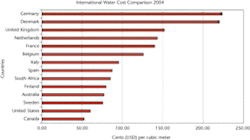Worldwide survey reveals water costs rising
Water prices are rising beyond inflation rates in countries that are experiencing water shortages and implementing efforts to improve water quality, according to NUS Consulting Group's latest global survey.
NUS Consulting Group reported that water prices increased in 11 of 14 countries included in its 2003-2004 International Water Report and Cost Survey due to the implementation of costly measures to improve water quality and increase conservation.
The surveyed countries include: Australia, Belgium, Canada, Denmark, Finland, France, Germany, Italy, Netherlands, South Africa, Spain, Sweden, United Kingdom, and the United States.
Germany retained its title of having the highest water prices of the surveyed countries with a water price of US$ 2.23 per cubic metre. Denmark closely trails Germany at roughly US$ 2.20 per cubic metre. Inflation accounted for price increases in many countries; however Australia, Spain, South Africa, UK and the USA experienced hikes above inflation rates.
In South Africa, prices increased by 10.6% but Cape Town experienced the highest rise of more than 16% following a severe water supply shortage. Cape Town relies heavily on annual winter rainfalls, which have been abysmal over the past few years. Diminishing storage volumes have led to a governmental decision to construct a new dam on the Berg River.
Interior cities in South Africa report higher prices, indicating water resource scarcity. None of these cities are situated on or near a major river and must rely upon water from distant dams. One of the more significant problems facing water suppliers is unaccountable loss. In Durban, a lack of attention to the city water infrastructure has led to frequent service interruptions and major water losses due to leakage. The problem is not restricted to Durban as most other Councils have ignored routine maintenance of water pipes leading to major water losses. Prices are forecast to increase again above inflation rates as the nation's drought continues to have no end in sight.
In Australia, the average price of water increased by an alarming 7.2% over the 12-month survey period, well above the country's 2.5% inflation rate ending June 2004. This increase is mainly attributed to the 27% increase in water pricing experienced in the Australian Capital Territory (ACT). Removing the ACT from survey calculations brings the national price increase down to 2.4%, an outcome predicted in last year's water cost survey.
Apart from ACT, residential and commercial water rates offer very little incentive to reduce consumption. This is surprising given that Australia is a dry continent subject to unpredictable rainfall in most water catchment areas. More willingness to use water pricing as a means to promote conservation is becoming evident throughout the country. ACT water rates are structured to penalise high or excessive water users.
Australian water consumers may witness more innovative schemes to reduce dependence on pure water for non-drinking and food applications. Little progress has been made in this area, although the idea of using wastewater and treated sewage for purposes outside of human consumption is not new.
In the UK, water prices increased by 5.5% since July 2003, higher than the rate of inflation at 2.8%. Most customers' bills remain lower than they were in 1999-2000 despite broad price increases. The continuing evolution of the water sector in the UK is moving towards an important crossroads. Not surprisingly, some are calling for a significant price increase to allow for an economically sustainable future through investment. Mixed with security of supply via "drought-hit" reservoirs and the prospect of the Spring 2005 general election, the water sector may fast become a major political issue.
Further emphasis has been directed at leakage prevention given the nation's ageing infrastructure. Drinking water quality for England and Wales maintained high standards where 99.87% of all tests passed current water quality directives.
New pricing limits for 2005-2010 set by Ofwat are widely expected to permit significant price increases, although these are likely to be staggered to alleviate political concerns. The average bill increase sought by UK water companies over the next five-year period is 29%. Southern Water's final business plan submitted to Ofwat proposed an increase of 45%, highlighting the problems facing water companies in high-population areas included in the government's plan for 200,000 extra homes and the ever-present risk of drought and flooding.
The final decision on prices will be made in December 2004 and implemented on 1 April 2005. NUS Consulting Group anticipates an increase above the rate of inflation over the next 12 months.
Author's Note
Richard D. Soultanian is the co-president of NUS Consulting Group, based in Park Ridge, New Jersey, USA. For more information on the survey, visit the website: www.nusconsulting.com.

